To get a high yield from the orchard, it is important to properly care for garden trees in the fall. Preparing trees for winter consists of a series of measures, which include fertilizing, pruning, treatment from diseases and pests. Digging and soil moisture are also important. If all these procedures are implemented before the first frost, this will facilitate wintering of the garden, as well as maintaining a good harvest.
Content
- 1 The Importance and Importance of Autumn Care
- 2 Proper maintenance of the garden in the autumn by month
- 3 Autumn garden plan
- 3.1 Whitewash trunks
- 3.2 Sanitary pruning
- 3.3 Preventive treatment of the garden from diseases
- 3.4 Autumn top dressing
- 3.5 Features of caring for seedlings of fruit trees in autumn
- 3.6 Insect garden protection
- 3.7 Protecting the garden from rodents
- 3.8 Watering the garden trees
- 3.9 Digging tree
- 3.10 Leaf cleaning
- 4 Tips for Beginners
- 5 Finally
The Importance and Importance of Autumn Care
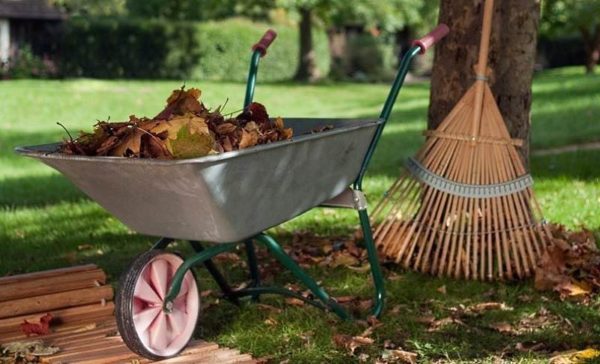
As soon as the last crop was harvested from trees and shrubs, it is time to start preparing the garden for wintering. It is necessary to carry out a number of important events that will increase their winter hardiness, namely:
- strengthening immunity;
- branch volume reduction;
- protection against diseases, pests;
- top dressing;
- watering, digging;
- whitewashing of trees;
- leaf cleaning.
Such procedures allow plants to withstand severe frosts or sudden thaws. If you skip some stage, then in the spring you will have to catch up, and this may cause a lack of crop or plant death.
Proper maintenance of the garden in the autumn by month
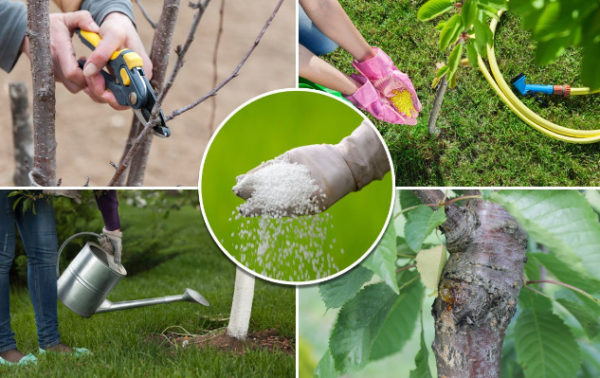
In the fall, care for fruit trees and the garden includes certain procedures that are recommended to be done depending on the month. In September, you need to start harvesting, as well as planting fruit trees and shrubs. In October, shoots and tops are cut and removed. In addition, whitewash occurs. In November, fallen leaves are collected, as well as cut branches, digging and fertilizing each trunk or shrub.
September, where to start
September is considered an important month for any gardener. This month there is an active harvest from the fields, gardens and orchards. The main classes include:
- The collection of some fruits, namely pears and apples. For long-term storage of fruits, it is important to collect them on time. The optimal period is mid-September. If the fruits are overexposed on the branches, then they will not be stored for a long time.
- Planting fruit crops. It can be apricots, apples, peaches, pears, and grapes, gooseberries and currants can also be planted.
- Pruning fruit trees and shrubs. A broken or diseased vine must be removed; dry branches are also removed. After pruning, it is necessary to process shrubs with trees from various diseases and pests.
- Harvesting the latest vegetable crops. The first frosts can negatively appear on potatoes or tomatoes.
- It is time to plant winter garlic in order to get a crop in early spring.
For those who grow flowers, September is a busy month. This month there is an active collection of seeds, planting bulbs of daffodils, tulips and other various types of flowers.
What to do in October
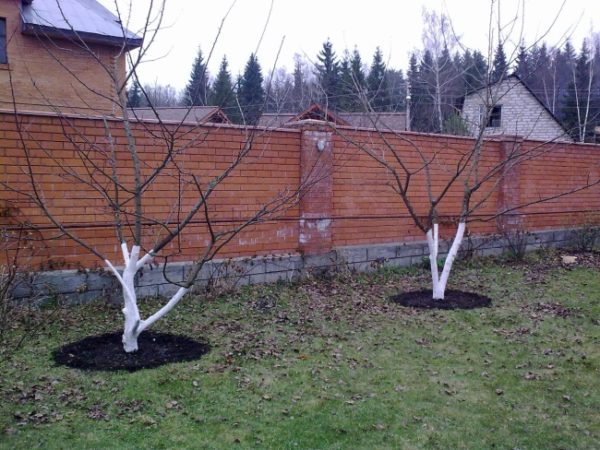
In October, it's time for the transplant of trees and shrubs. Only first you need to wait until they drop all their leaves. At this time, you can begin to collect late varieties of fruits. There are varieties that are harvested, then delayed for ripening. The next stage is feeding the plants, cultivating with soil cultivation.
Also in October there is a landing of siderates. In the southern regions, it is best to plant them in the early days of the month, and for the northern and central regions, planting a crop is not recommended, as the spring crop simply does not ripen. And rye and winter wheat will ripen and grow well. If siderata were planted earlier, then in October they can be dug up so that they fill the soil with organic substances.
If acidity is increased in the area, then this month it can be lowered. This occurs using chalking or lime. During this period, flower bulbs can still be planted in the ground. And when the first frosts appear, it is necessary to carefully uproot the tubers of begonias, dahlias, queens, gladioli and anemones.
November, preparing the garden for winter
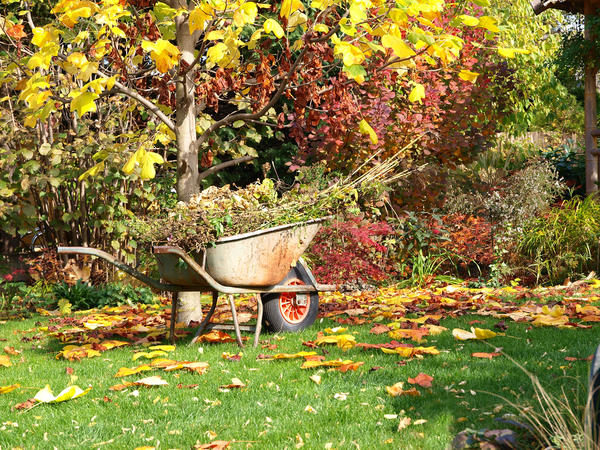
In November, they are completing work on preparing the garden and wintering grounds. First of all, you need to cover some plants. For example, there is a certain grape variety, the vine of which is sheltered for the winter even in the southern regions, where a mild climate prevails.
The trunks of the trees are lime. This is done in order to protect from exposure to sunlight in the spring, as well as to protect against pests and rodents. The sun's rays can burn the bark, as a result of which cracks can form. If the regions are characterized by cold weather, then the fruit trees in the autumn period are insulated with peat and the trunks are wrapped with cloth, which allows air to pass through.
Autumn garden plan
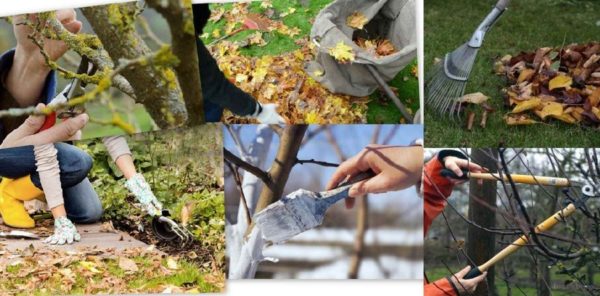
Proper autumn care of the orchard begins in September and ends two weeks before the first frost. In order not to miss anything, it is recommended to draw up a preliminary plan depending on the region of residence, and starting from it to carry out all relevant activities. The main garden care activities include:
- a scavenger is going from the ground, pests are being destroyed;
- planting of young seedlings in October, when there are frequent rains and significant cooling is felt;
- pruning of fruiting plants;
- whitewashing of tree trunks;
- carry out preventive work against fungus and rot;
- processing branches and trunks from insects hidden inside;
- collection of fallen leaves and cut branches, their burning;
- digging trees;
- fertilizing and fertilizing plants.
If necessary, the plants are insulated and protected from rodents. Especially carefully you need to protect young seedlings, as they are more exposed to attack by rodents and pests.
Whitewash trunks
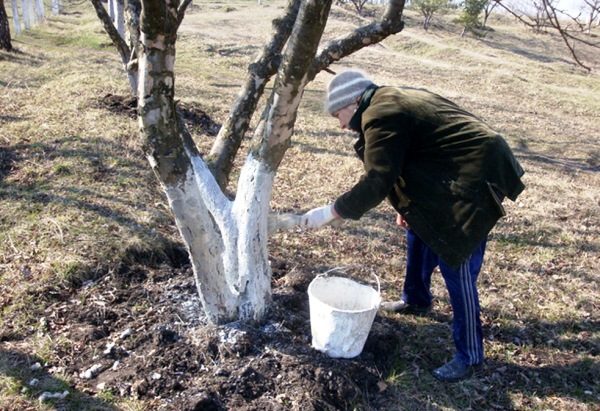
Whitewash fruit trees in the autumn is very important. It protects the plant from:
- From insects that lay their larvae, they harm the plant.
- Protection against temperature changes. In the daytime, the crust warms up from the sun, and in the night and evening it is exposed to severe frosts.
- When the tree has not yet managed to become leafy in the spring, whitewash protects it from burns.
- Protection against fungal diseases.
The solution is prepared in several ways. The simplest solution is considered, which includes lime, copper sulfate and water. For 10 liters of water you will need 2 kg of lime and 400 grams of copper sulfate. A little paste can be added to the solution to increase the viscosity, as well as cow manure or 1 kg of clay.
However, when caring for young trees, it should be remembered that paste is not used for whitewashing. It does not allow air to penetrate to the cortex. For young fruit trees, the solution is prepared from 1.5 kg of clay, 3 kg of lime and 1 kg of cow manure.All ingredients are soluble in water.
There is another option - the purchase of a ready-made mixture for whitewashing tree trunks. The mixture may be inexpensive and include clay and lime. However, it is washed off very quickly by rains, and it will need to be applied several times. But you can buy a drug more expensive - a mixture containing carbolic acid. This will not only allow whitewashing to stay on trunks for a long time, but also protect against various rodents and hares.
Sanitary pruning
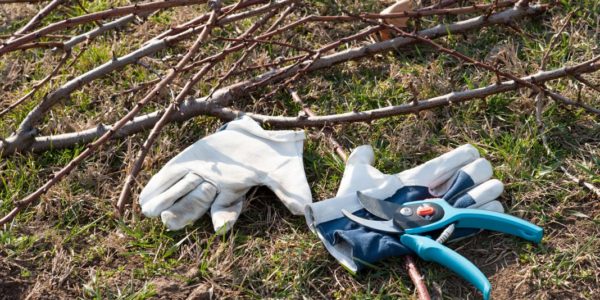
Tree pruning should be done at least twice a year - in spring and autumn. In autumn, bushes and trees are pruned before frost, when all the foliage has already fallen. However, do not overdo it, as excessive pruning may not benefit, but harm the tree.
The simplest pruning involves the removal of dried processes or branches that have undergone illness. To prevent infection of other fruit trees and shrubs, such branches are recommended to be burned outside the garden. If the branch is dried, then when it is removed, no harm is done to the tree. If you had to cut off a shoot that got sick, then the cut should be treated with linseed oil or oil paint, since these branches are considered still alive.
The main goal in this procedure is to improve the flow of air and sunlight along the entire crown. Thanks to sanitary pruning, the crown is correctly formed, as excess branches, and those that grow down or towards the crown, are removed. Those branches that cross among themselves are also subject to deletion. To maximize the sun's rays from the tree, the branches should be distributed evenly on all sides. Shortening branches is also considered an important procedure. Thanks to this, you can easily set the correct growth direction.
Preventive treatment of the garden from diseases
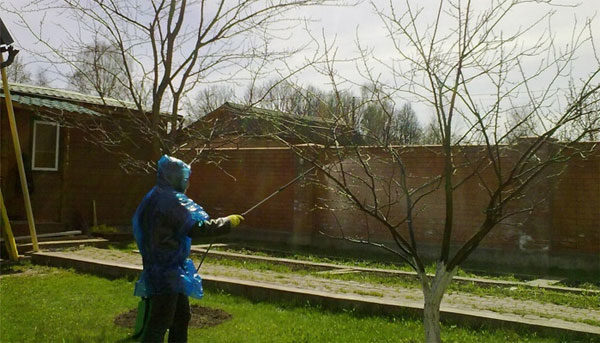
From various diseases, fruit bushes and trees are treated with special medicinal substances. As a prevention of various spotting use drugsthat contain copper, copper sulfate solution, or Bordeaux fluid. Prevention with fungicides such as Topsin is possible. Chorus or Cuproxate.
Such medicinal substances as Strobi, Impact or Skor can get rid of the occurrence of rot or scab. If cracks or any other wounds have formed on the cortex, then they must be treated with five percent copper sulfate. After processing they are covered with cement.
With special iron brushes, branches and trunks are cleaned of dead bark, as the larvae of apple moth, silkworm and other insects hide in it.
Autumn top dressing
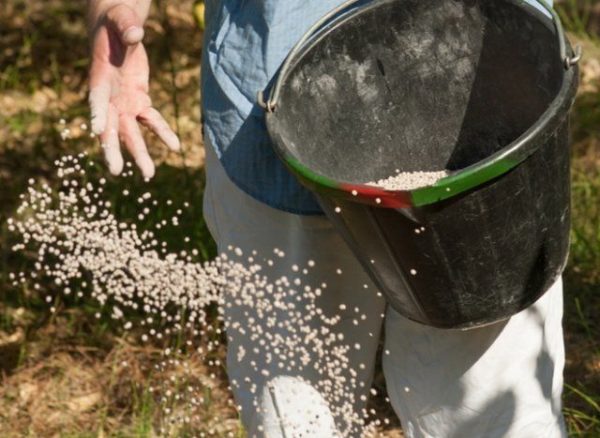
Autumn care for adults and young trees also includes top dressing. It is very important, as it provides the plant with high immunity, due to which it can withstand severe frosts and increase fruiting in the new season. Make top dressing at the moment when the trunks are dug.
There are two types of fertilizer in the autumn:
- Humus.
- Phosphorus and potash fertilizers.
Humus is made depending on the age of the tree. If he is less than 8 years old, then 30 kg of humus is enough, if older, then from 50 kg. By spring, the substance will have time to overheat and the plant will receive the necessary portion of the nitrogen supplement.
Monopotassium phosphate is considered a popular phosphorus-potassium fertilizer. It consists of 34% potassium and 54% phosphorus. This drug is absorbed by the whole plant. However, it is expensive, so it is recommended to apply to very fastidious crops.
Potassium preparations include potassium chloride and sulfate. Shrubs should not be treated with potassium chloride, as it is able to inhibit them. Potassium chloride does not cause a negative result on trees.Potassium sulfate is suitable for feeding both trees and bushes. For one square meter, it needs from 5 to 10 grams.
Ammophos and superphosphate are considered to be popular phosphate fertilizers. Superphosphate is more preferable for autumn top dressing, since nitrogen is present in ammophos.
Features of caring for seedlings of fruit trees in autumn
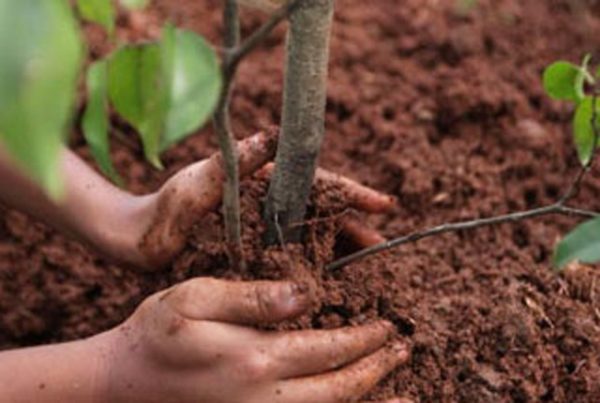
Care for young trees after planting consists in mulching the soil and garter to the support (stake). In order to avoid damage to the root system, digging is carried out carefully to a maximum depth of 15 cm.
The young bark of seedlings is very attractive to mice and hares. To protect the young plant from attack, you need to hide the bark of the tree under a special covering material. As a covering material, there may be a simple mesh with small cells. You can also use ordinary synthetic stockings and tights.
Insect garden protection
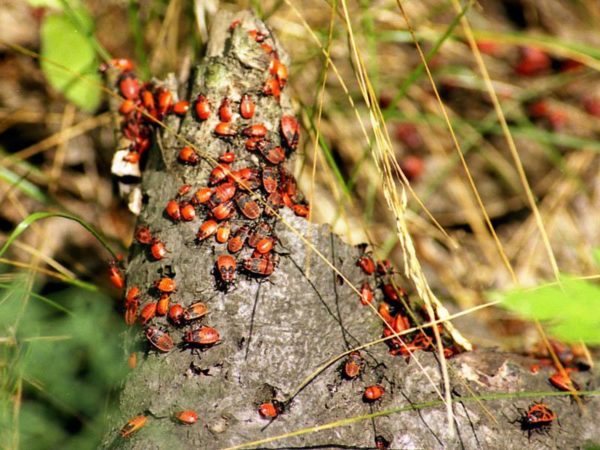
The tree bark serves as a comfortable place for overwintering a variety of insects. They can lay their larvae in the cortex, in the nests of the crown, as well as in fallen leaves. To protect the garden from insects, you must perform the following steps:
- Cleaning the entire garden from foliage and other debris. Using a special iron brush, peel the bark of a tree. And to destroy the wintering of caterpillars in the soil, dig the soil 15 cm deep.
- Good to inspect all plants. Treat cracks and abrasions of tree bark with 5% copper sulfate and grease with cement.
- Sprinkle the garden urea solution (3 or 5%), as well as drugs that contain copper.
These manipulations will help protect the garden from such popular insects as the stalk, silkworm, aphid or lungwort.
Protecting the garden from rodents
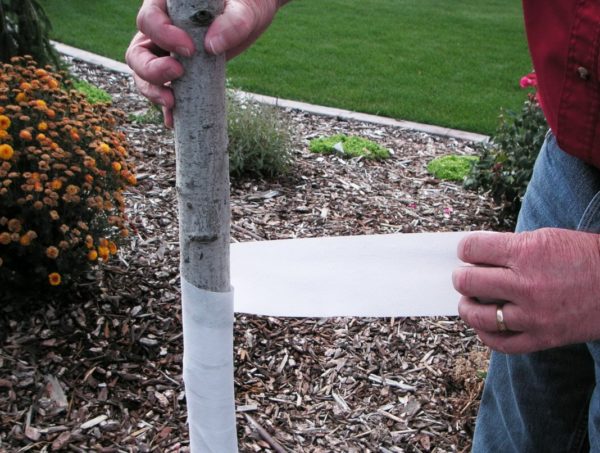
Garden trees and shrubs are very easily attacked by various small rodents and hares. For protective purposes, the trunk is wrapped in matter. For example, it may be burlap or an old rag with roofing material.
And to prevent mice from reaching the trunk, the matter with which the tree is hiding must be well buried with earth at the base. The garden can also be protected from small rodents with the help of pine or spruce branches. They are placed in a circle around the trunk and the trunk is tied. Mice can also be scared off with branches of coriander. If they are scattered near the tree, then the mice may be frightened by their smell.
Watering the garden trees
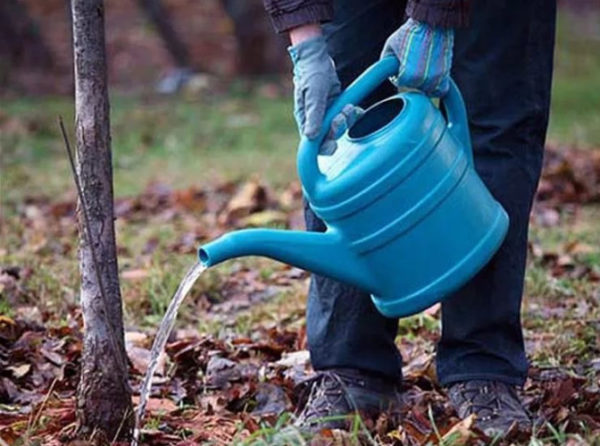 Before wintering, it is recommended to water the garden only in those regions where a small amount of rainfall occurs. With normal humidity in the region, watering is recommended in October, but not later.
Before wintering, it is recommended to water the garden only in those regions where a small amount of rainfall occurs. With normal humidity in the region, watering is recommended in October, but not later.
Watering in the fall along with hilling the ground of the plant base instead of benefit can harm the tree. Therefore, hilling of trees is allowed only in regions where there is little snow and severe frosts.
The last watering before winter charges the tree with moisture and strengthens its root system. In winter, the roots are able to receive moisture from a depth of 1.5-2 meters. In addition, watering before wintering improves the growing season, replaces watering in the spring, and also protects the tree from sunburn.
When watering, it is important to remember that excess moisture is just as dangerous as its lack. If the tree does not have enough moisture, then it will not be able to develop immunity to severe frosts. An average of 10 to 16 winds of water per square meter is enough.
Digging tree
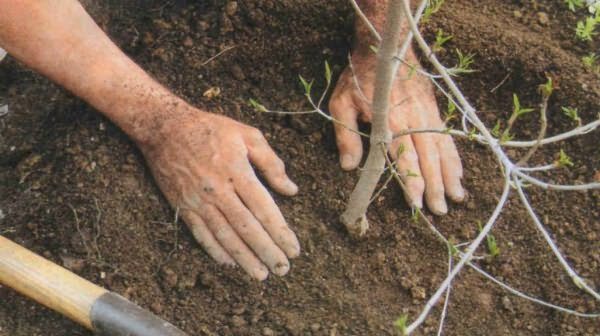
Asking the question: whether it is necessary to dig trees in the fall, inexperienced gardeners believe that this can be transferred to the spring. However, autumn digging is indispensable and very important.With its help, the larvae of harmful and dangerous pests die, the soil is saturated with oxygen, and the seeds and roots of various weeds decompose.
Digging should be done no later than October. The root system of young seedlings is not deep, so deep digging is not recommended for them. The location of the measles system depends on the variety of fruit tree. For example, in an apple tree, the roots are in a radius of 20 to 60 cm around the trunk, in a plum, from 20 to 40 cm.
In order to prevent the earth from freezing and weathering, it is necessary to dig fruit trees carefully and not to break large clumps of earth. Digging the ground in late autumn is also not recommended, since early snow will not allow the ground to warm up well and quickly in the spring.
Leaf cleaning
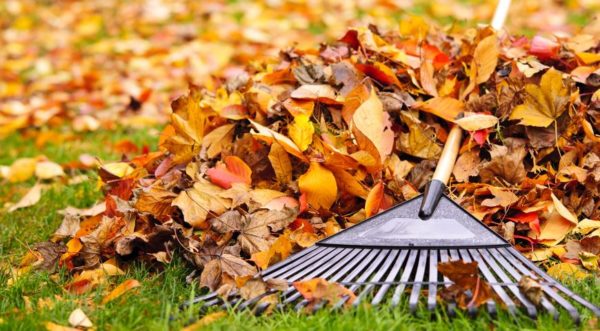
In autumn, when caring for fruit trees, it is also important to do leaf cleaning. Various larvae of insects or pests hide in the leaves for the winter, and the remnants of disease spores are also possible. This must be taken into account when cleaning the garden.
If the site was not exposed to various diseases, and pests did not attack it, then the fallen leaves can serve as a good fertilizer. To do this, you need to collect all the foliage in bags, and in the spring pour it into one pile for decaying. During the winter, all harmful microorganisms, if they remain in the foliage, die in the cold. If fallen foliage is susceptible to attack by pests and various diseases, then such foliage should be collected and burned.
Tips for Beginners
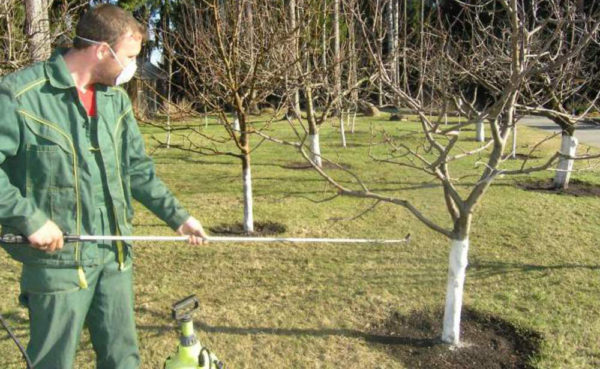
For beginner gardeners, there are some useful tips. With their help, you can grow a good harvest next year, while not harming the garden. As a rule, at the end of August, most shoots in the garden stop growing and a final bud is formed. For the rapid formation of flower buds, top dressing and periodic watering are recommended.
The main actions for gardening are:
- Stands for trees. If the crop turned out to be generous and rich, then you should worry about protecting the branches from damage from heavy fruits. For this, special supports are constructed.
- Top dressing. To protect the orchard from frost, you need to make phosphorus-potash fertilizers in the fall. They increase the immune system of the plant and increase its frost resistance.
- Whitewashing trunks. It protects against diseases as well as pests. In addition, it does not allow the bark to get burns from sunlight.
- Removing dead and dried branches.
Do not forget about the protection against various diseases, from pests and rodents that attack the garden.
Finally
Neglecting work in the garden in the autumn is not worth it. After all, with proper autumn care for a bush or tree in the garden, the correct formation of plant growth is ensured. That is why the future harvest is completely dependent on how quality and thorough the tree care was. After all, when caring for the garden in the fall, the gardener protects the plant from diseases, rodents and pests, improves its immunity, and fills it with all the necessary nutrients.

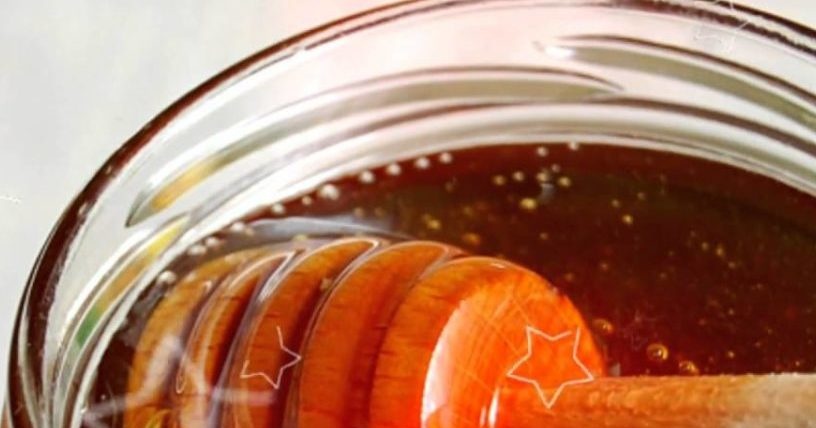
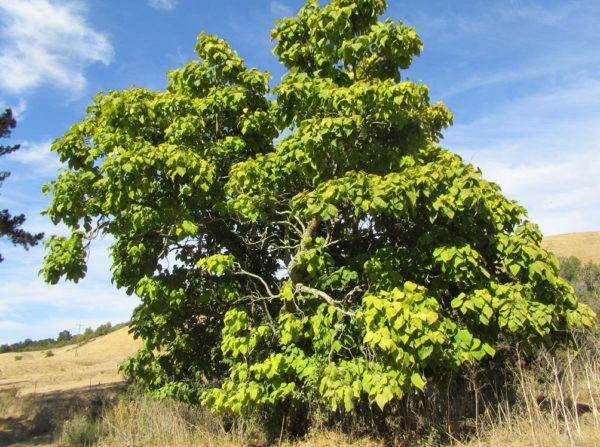
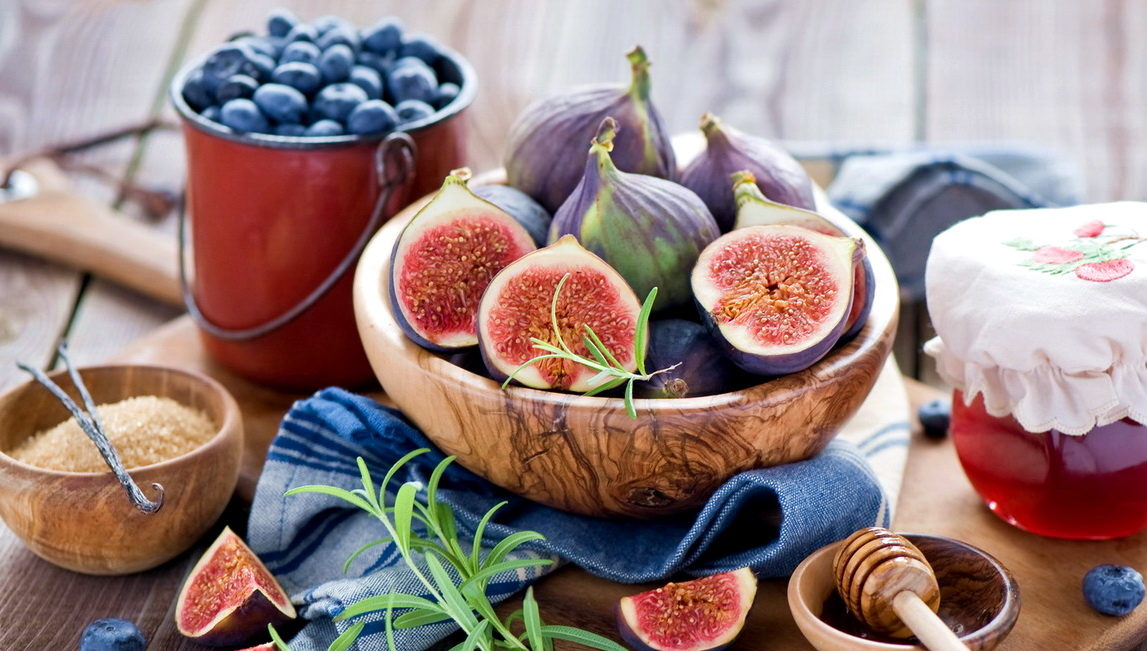
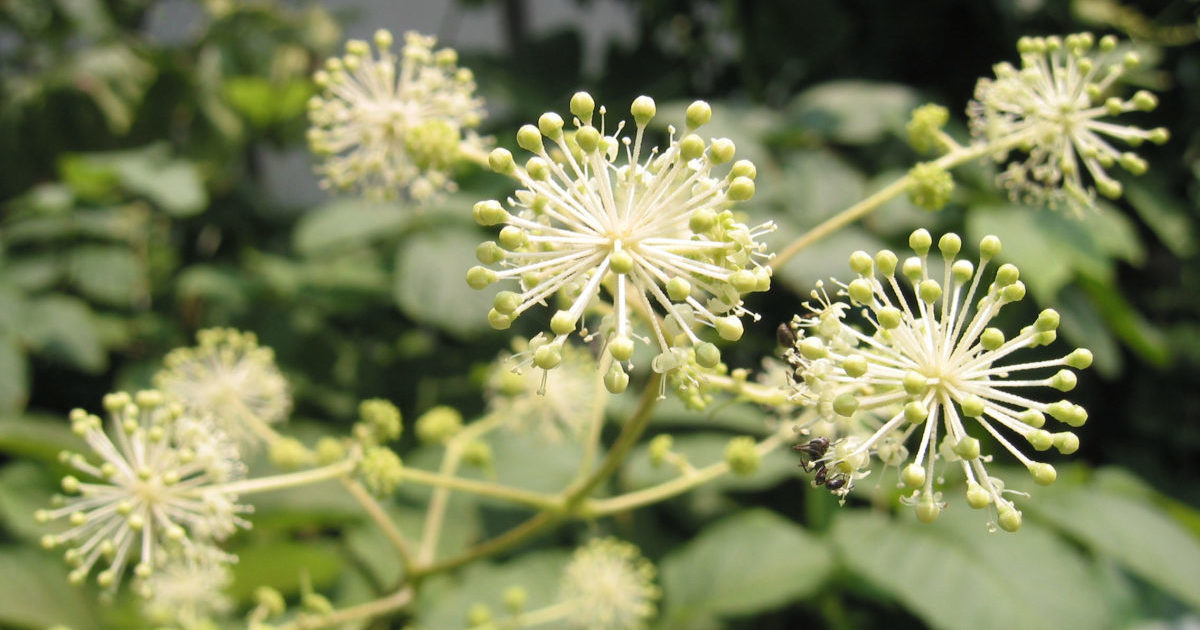 Aralia Manchurian - medicinal properties and contraindications, the use of tinctures in bodybuilding
Aralia Manchurian - medicinal properties and contraindications, the use of tinctures in bodybuilding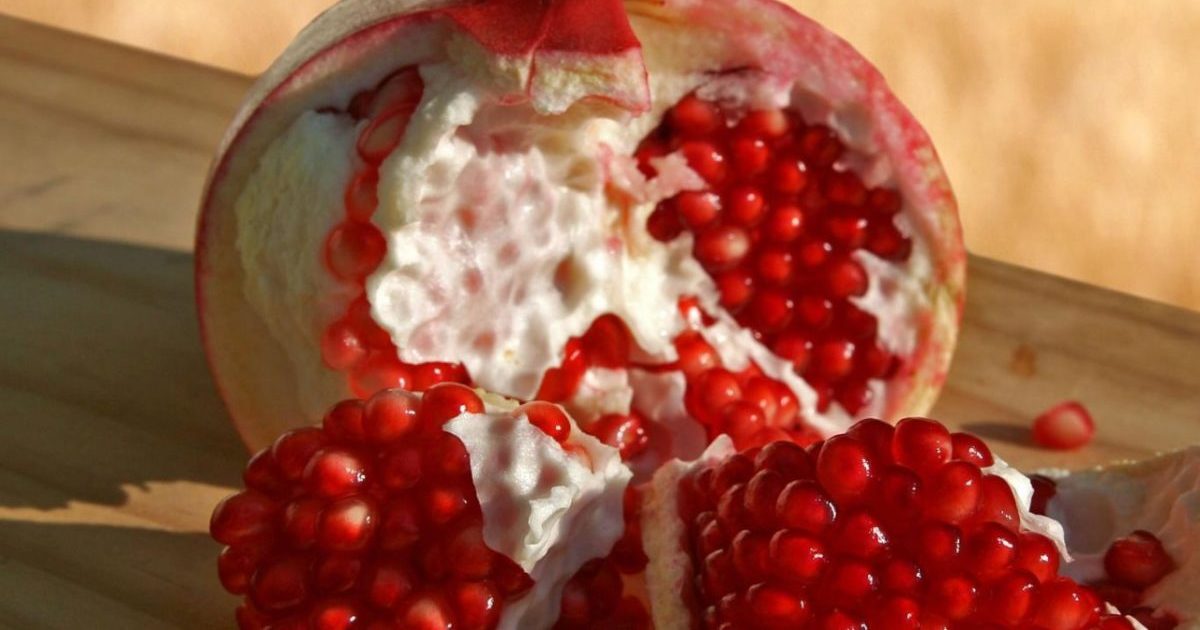 Seedless pomegranate - cutaway appearance, benefits and harms
Seedless pomegranate - cutaway appearance, benefits and harms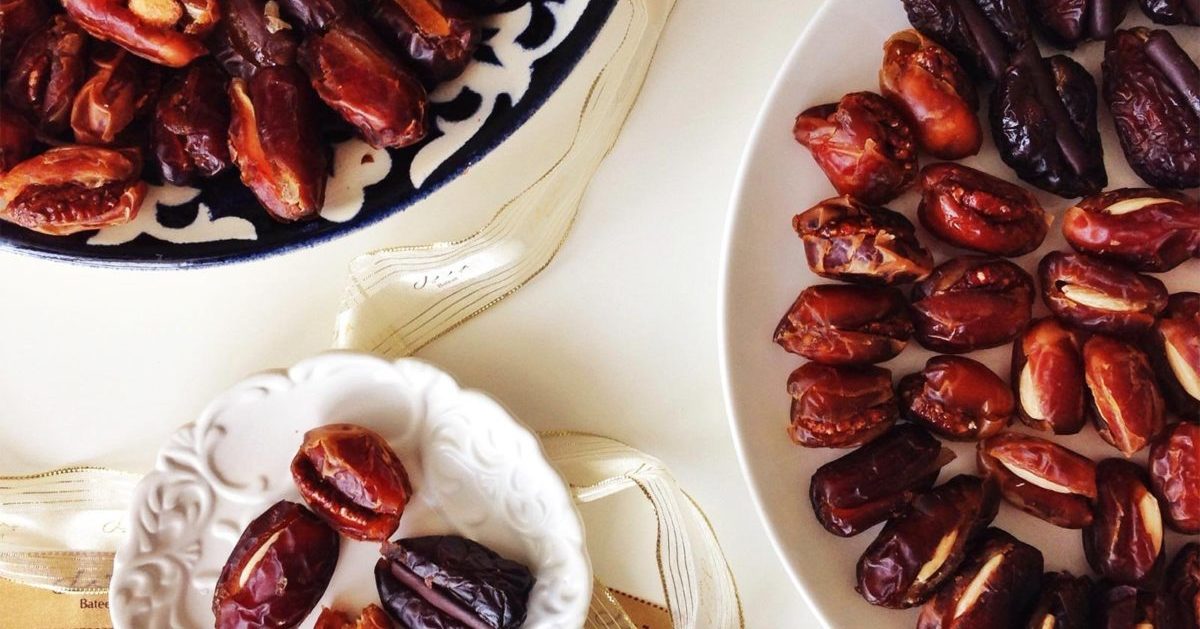 Dates - the benefits and harm to the body, how much you need to eat, properties and calorie content
Dates - the benefits and harm to the body, how much you need to eat, properties and calorie content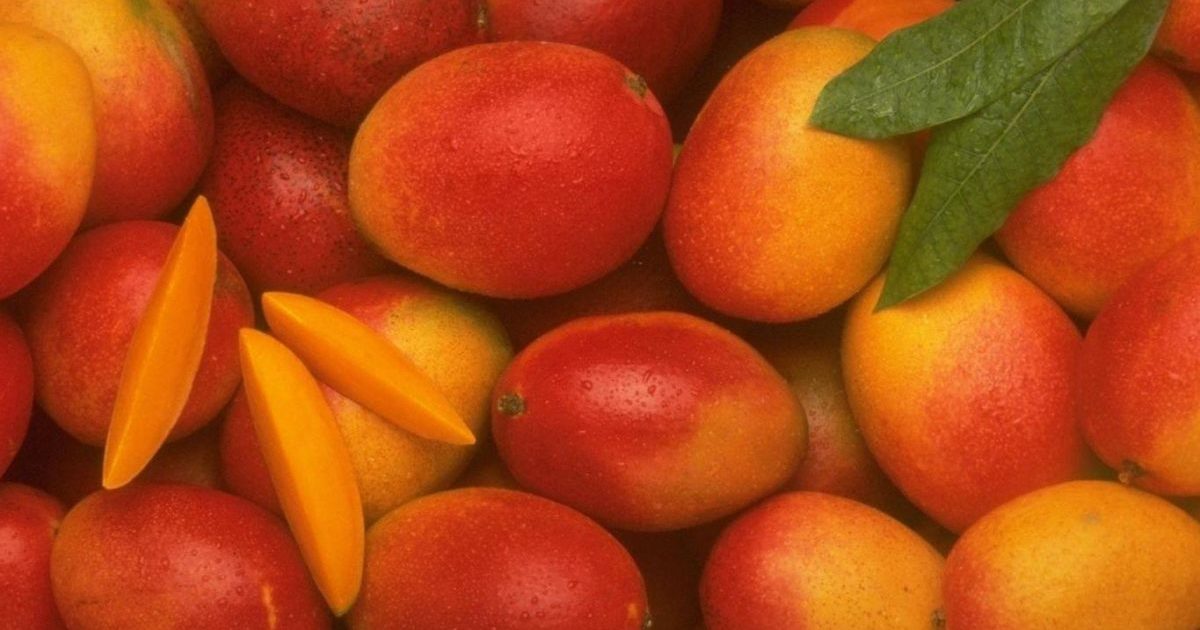 The benefits and harms of mango for the body of women and men - how to eat it?
The benefits and harms of mango for the body of women and men - how to eat it?